Hospitality Business Toolkit Report: Financials, HR, and Legislation
VerifiedAdded on 2021/02/19
|10
|2405
|53
Report
AI Summary
This report provides an overview of the hospitality business toolkit, covering key aspects such as financial performance, HR cycles, and relevant legislation. It begins by exploring the principles of managing financial performance, including liquidity, solvency, profitability ratios, cash flow, and return on investment. The report then delves into the double-entry bookkeeping system and trial balance. Furthermore, it examines the different stages of the HR cycle, emphasizing recruitment, enablement, and development, along with a professional development plan. The report also addresses the laws and legislation that the hospitality industry must adhere to, including minimum wage rates and health and safety regulations, and how these impact business decisions. Finally, it explores the interrelation of functional roles within the hospitality sector, such as finance, marketing, HR, production, and research and development, and discusses various methods of communication, coordination, and monitoring used to strengthen value within a hospitality organization. The report concludes with an overview of the key findings and references to relevant sources. This report is contributed by a student to be published on the website Desklib, a platform which provides all the necessary AI based study tools for students.
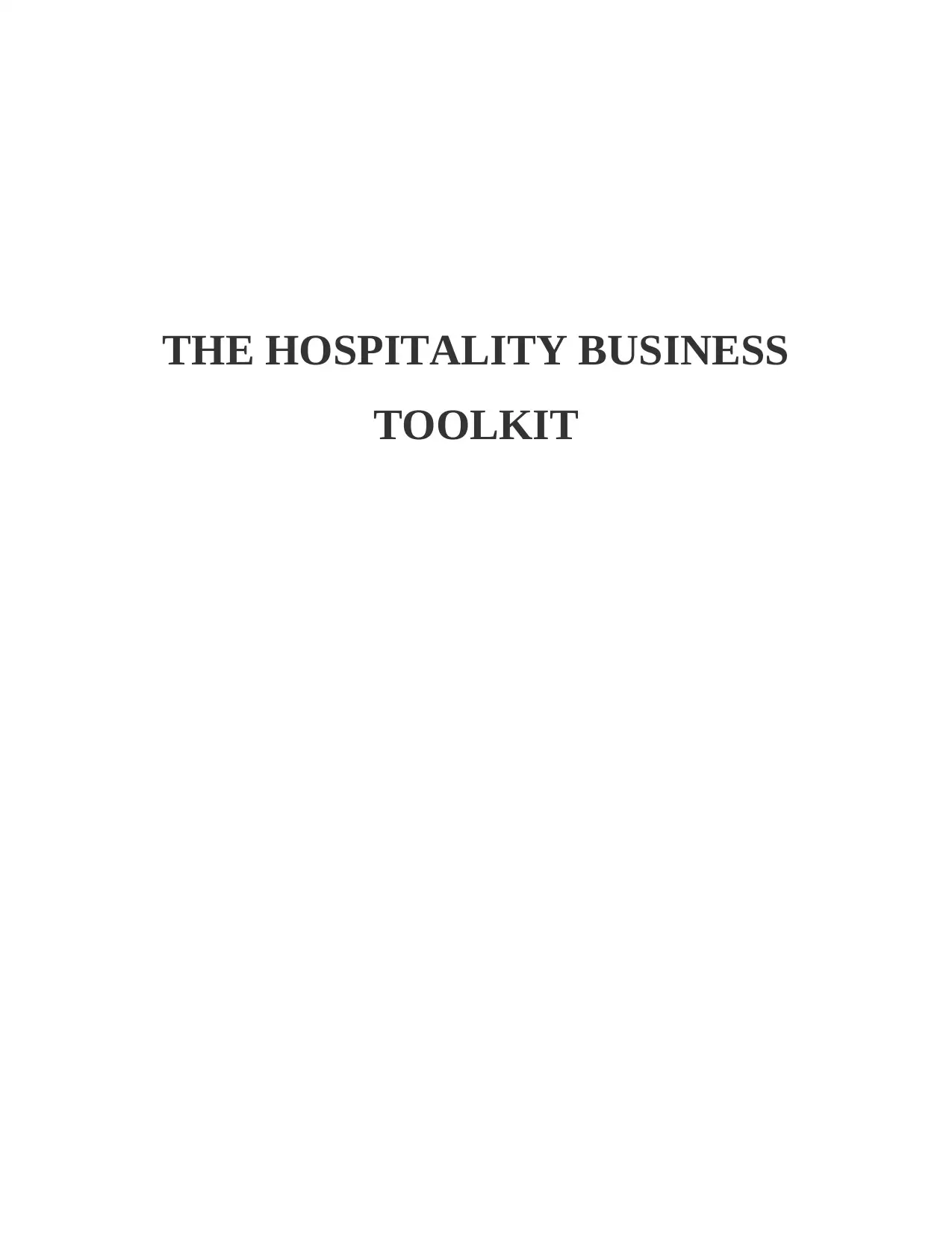
THE HOSPITALITY BUSINESS
TOOLKIT
TOOLKIT
Paraphrase This Document
Need a fresh take? Get an instant paraphrase of this document with our AI Paraphraser
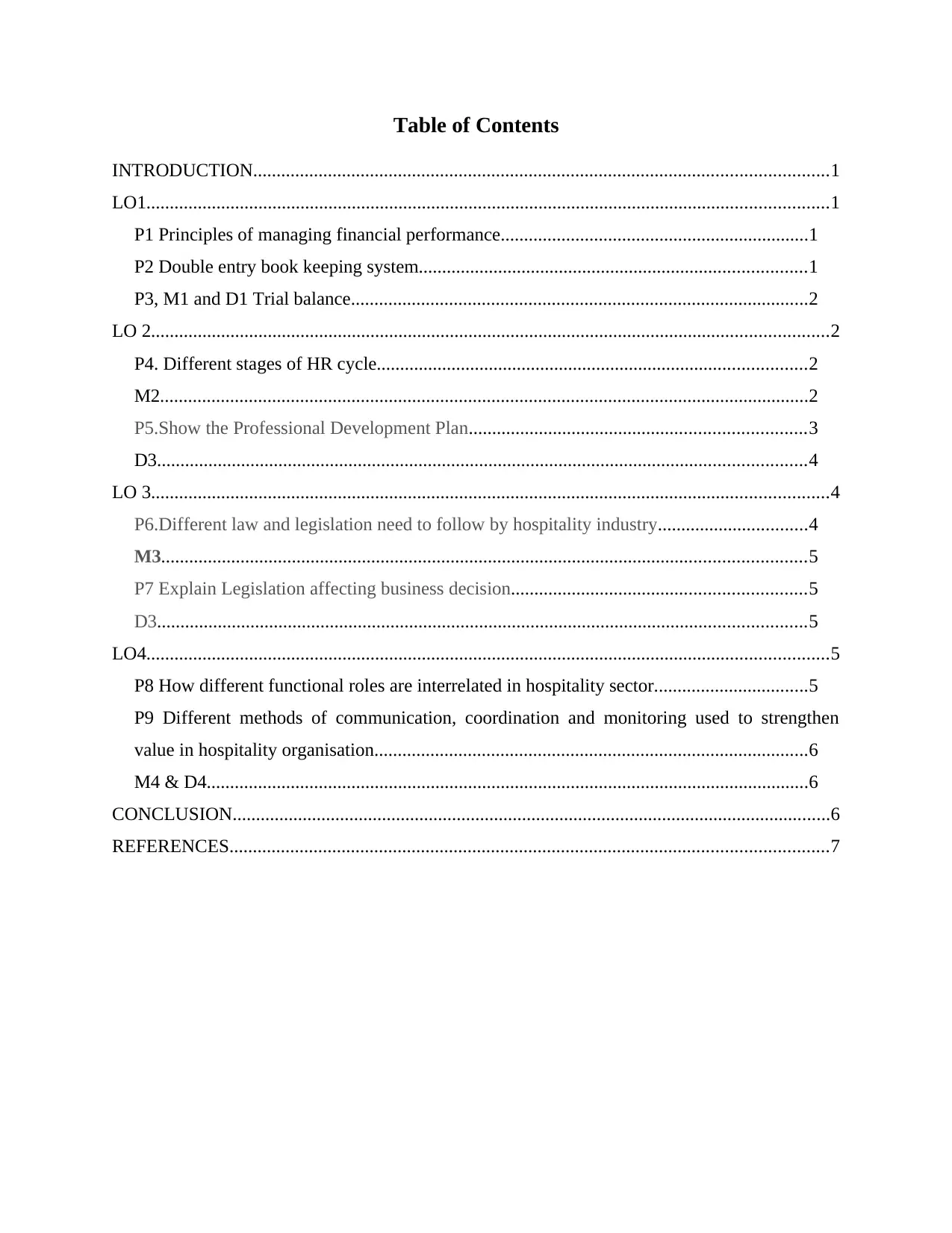
Table of Contents
INTRODUCTION...........................................................................................................................1
LO1..................................................................................................................................................1
P1 Principles of managing financial performance..................................................................1
P2 Double entry book keeping system...................................................................................1
P3, M1 and D1 Trial balance..................................................................................................2
LO 2.................................................................................................................................................2
P4. Different stages of HR cycle............................................................................................2
M2...........................................................................................................................................2
P5.Show the Professional Development Plan........................................................................3
D3...........................................................................................................................................4
LO 3.................................................................................................................................................4
P6.Different law and legislation need to follow by hospitality industry................................4
M3..........................................................................................................................................5
P7 Explain Legislation affecting business decision...............................................................5
D3...........................................................................................................................................5
LO4..................................................................................................................................................5
P8 How different functional roles are interrelated in hospitality sector.................................5
P9 Different methods of communication, coordination and monitoring used to strengthen
value in hospitality organisation.............................................................................................6
M4 & D4.................................................................................................................................6
CONCLUSION................................................................................................................................6
REFERENCES................................................................................................................................7
INTRODUCTION...........................................................................................................................1
LO1..................................................................................................................................................1
P1 Principles of managing financial performance..................................................................1
P2 Double entry book keeping system...................................................................................1
P3, M1 and D1 Trial balance..................................................................................................2
LO 2.................................................................................................................................................2
P4. Different stages of HR cycle............................................................................................2
M2...........................................................................................................................................2
P5.Show the Professional Development Plan........................................................................3
D3...........................................................................................................................................4
LO 3.................................................................................................................................................4
P6.Different law and legislation need to follow by hospitality industry................................4
M3..........................................................................................................................................5
P7 Explain Legislation affecting business decision...............................................................5
D3...........................................................................................................................................5
LO4..................................................................................................................................................5
P8 How different functional roles are interrelated in hospitality sector.................................5
P9 Different methods of communication, coordination and monitoring used to strengthen
value in hospitality organisation.............................................................................................6
M4 & D4.................................................................................................................................6
CONCLUSION................................................................................................................................6
REFERENCES................................................................................................................................7
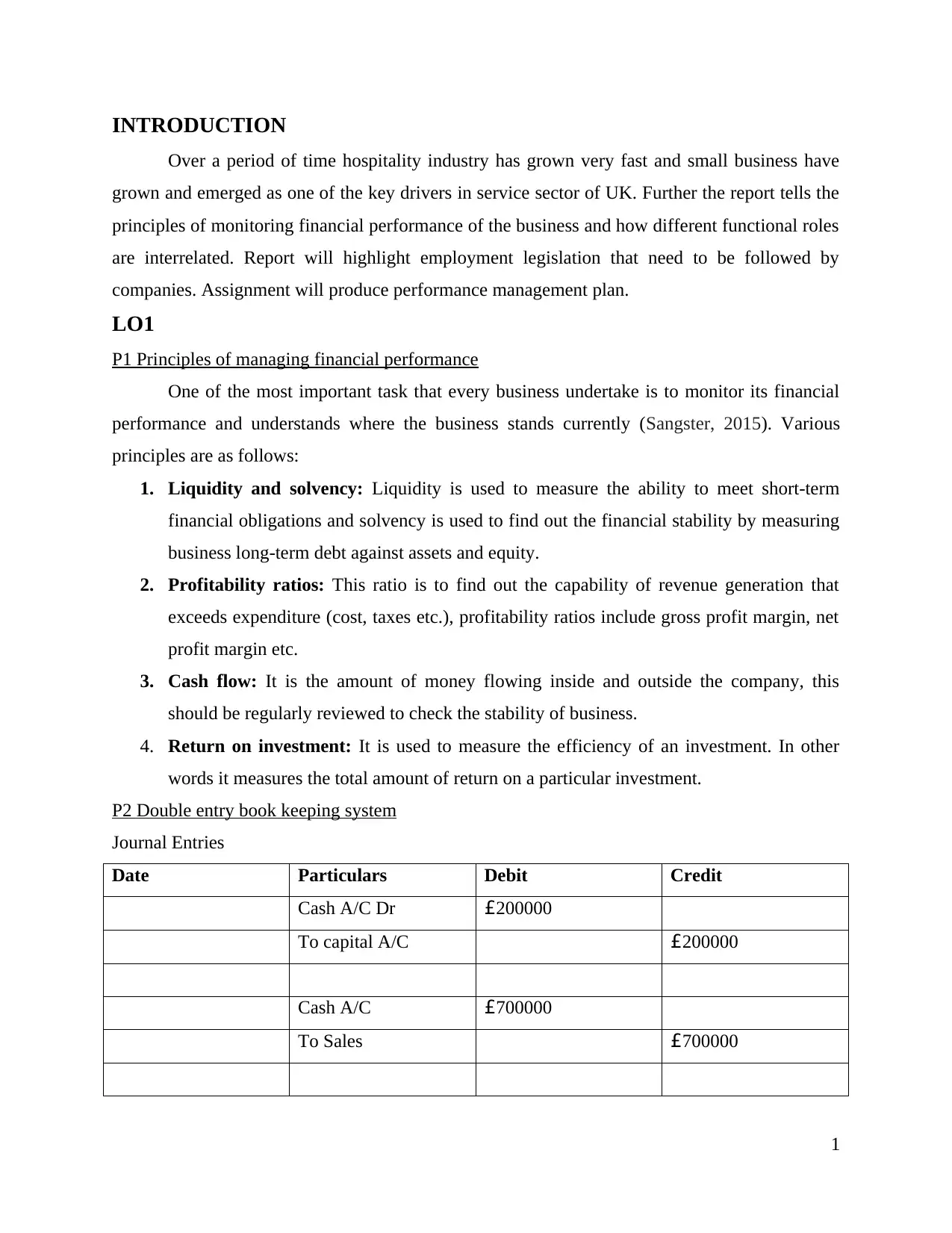
INTRODUCTION
Over a period of time hospitality industry has grown very fast and small business have
grown and emerged as one of the key drivers in service sector of UK. Further the report tells the
principles of monitoring financial performance of the business and how different functional roles
are interrelated. Report will highlight employment legislation that need to be followed by
companies. Assignment will produce performance management plan.
LO1
P1 Principles of managing financial performance
One of the most important task that every business undertake is to monitor its financial
performance and understands where the business stands currently (Sangster, 2015). Various
principles are as follows:
1. Liquidity and solvency: Liquidity is used to measure the ability to meet short-term
financial obligations and solvency is used to find out the financial stability by measuring
business long-term debt against assets and equity.
2. Profitability ratios: This ratio is to find out the capability of revenue generation that
exceeds expenditure (cost, taxes etc.), profitability ratios include gross profit margin, net
profit margin etc.
3. Cash flow: It is the amount of money flowing inside and outside the company, this
should be regularly reviewed to check the stability of business.
4. Return on investment: It is used to measure the efficiency of an investment. In other
words it measures the total amount of return on a particular investment.
P2 Double entry book keeping system
Journal Entries
Date Particulars Debit Credit
Cash A/C Dr £200000
To capital A/C £200000
Cash A/C £700000
To Sales £700000
1
Over a period of time hospitality industry has grown very fast and small business have
grown and emerged as one of the key drivers in service sector of UK. Further the report tells the
principles of monitoring financial performance of the business and how different functional roles
are interrelated. Report will highlight employment legislation that need to be followed by
companies. Assignment will produce performance management plan.
LO1
P1 Principles of managing financial performance
One of the most important task that every business undertake is to monitor its financial
performance and understands where the business stands currently (Sangster, 2015). Various
principles are as follows:
1. Liquidity and solvency: Liquidity is used to measure the ability to meet short-term
financial obligations and solvency is used to find out the financial stability by measuring
business long-term debt against assets and equity.
2. Profitability ratios: This ratio is to find out the capability of revenue generation that
exceeds expenditure (cost, taxes etc.), profitability ratios include gross profit margin, net
profit margin etc.
3. Cash flow: It is the amount of money flowing inside and outside the company, this
should be regularly reviewed to check the stability of business.
4. Return on investment: It is used to measure the efficiency of an investment. In other
words it measures the total amount of return on a particular investment.
P2 Double entry book keeping system
Journal Entries
Date Particulars Debit Credit
Cash A/C Dr £200000
To capital A/C £200000
Cash A/C £700000
To Sales £700000
1
⊘ This is a preview!⊘
Do you want full access?
Subscribe today to unlock all pages.

Trusted by 1+ million students worldwide
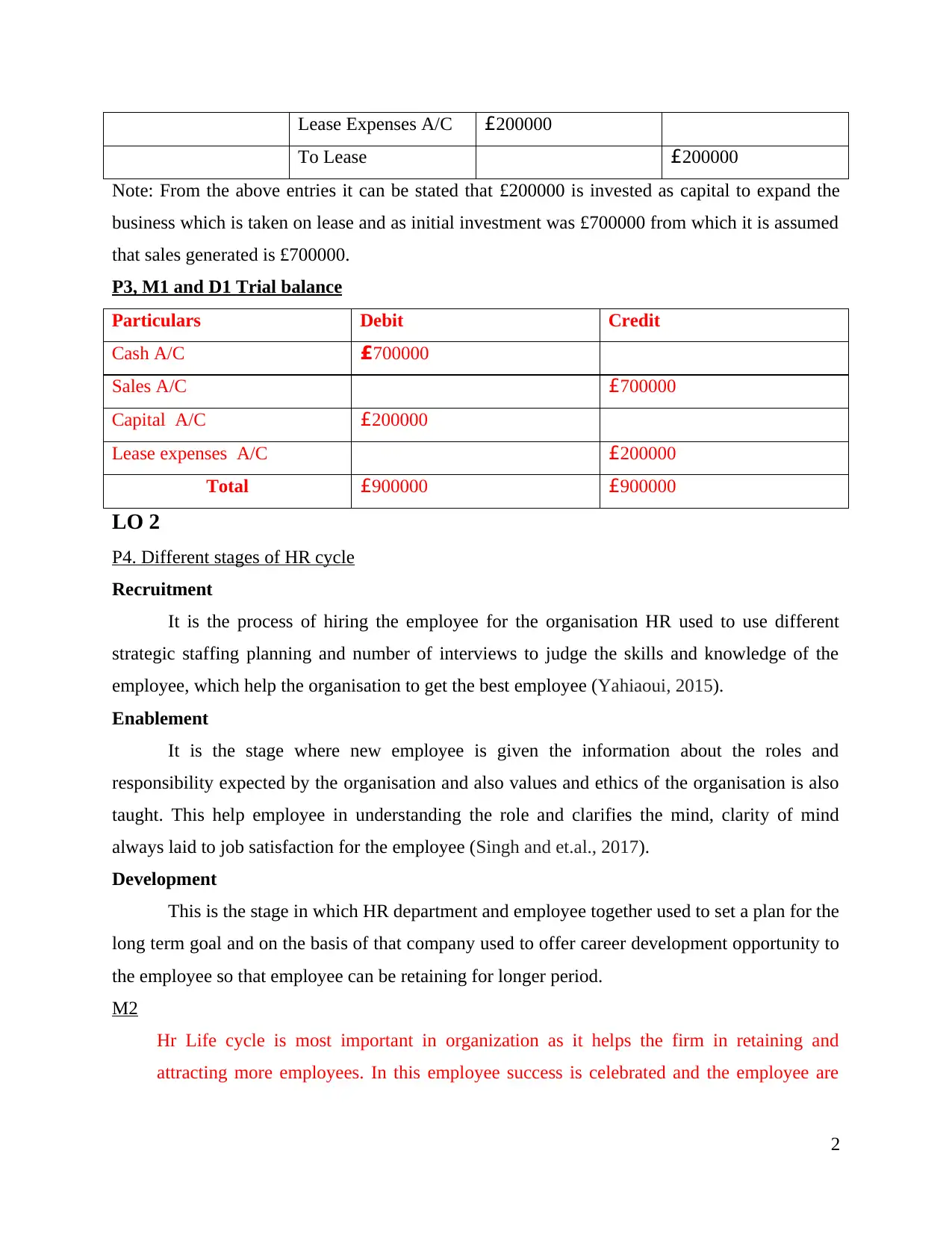
Lease Expenses A/C £200000
To Lease £200000
Note: From the above entries it can be stated that £200000 is invested as capital to expand the
business which is taken on lease and as initial investment was £700000 from which it is assumed
that sales generated is £700000.
P3, M1 and D1 Trial balance
Particulars Debit Credit
Cash A/C £700000
Sales A/C £700000
Capital A/C £200000
Lease expenses A/C £200000
Total £900000 £900000
LO 2
P4. Different stages of HR cycle
Recruitment
It is the process of hiring the employee for the organisation HR used to use different
strategic staffing planning and number of interviews to judge the skills and knowledge of the
employee, which help the organisation to get the best employee (Yahiaoui, 2015).
Enablement
It is the stage where new employee is given the information about the roles and
responsibility expected by the organisation and also values and ethics of the organisation is also
taught. This help employee in understanding the role and clarifies the mind, clarity of mind
always laid to job satisfaction for the employee (Singh and et.al., 2017).
Development
This is the stage in which HR department and employee together used to set a plan for the
long term goal and on the basis of that company used to offer career development opportunity to
the employee so that employee can be retaining for longer period.
M2
Hr Life cycle is most important in organization as it helps the firm in retaining and
attracting more employees. In this employee success is celebrated and the employee are
2
To Lease £200000
Note: From the above entries it can be stated that £200000 is invested as capital to expand the
business which is taken on lease and as initial investment was £700000 from which it is assumed
that sales generated is £700000.
P3, M1 and D1 Trial balance
Particulars Debit Credit
Cash A/C £700000
Sales A/C £700000
Capital A/C £200000
Lease expenses A/C £200000
Total £900000 £900000
LO 2
P4. Different stages of HR cycle
Recruitment
It is the process of hiring the employee for the organisation HR used to use different
strategic staffing planning and number of interviews to judge the skills and knowledge of the
employee, which help the organisation to get the best employee (Yahiaoui, 2015).
Enablement
It is the stage where new employee is given the information about the roles and
responsibility expected by the organisation and also values and ethics of the organisation is also
taught. This help employee in understanding the role and clarifies the mind, clarity of mind
always laid to job satisfaction for the employee (Singh and et.al., 2017).
Development
This is the stage in which HR department and employee together used to set a plan for the
long term goal and on the basis of that company used to offer career development opportunity to
the employee so that employee can be retaining for longer period.
M2
Hr Life cycle is most important in organization as it helps the firm in retaining and
attracting more employees. In this employee success is celebrated and the employee are
2
Paraphrase This Document
Need a fresh take? Get an instant paraphrase of this document with our AI Paraphraser
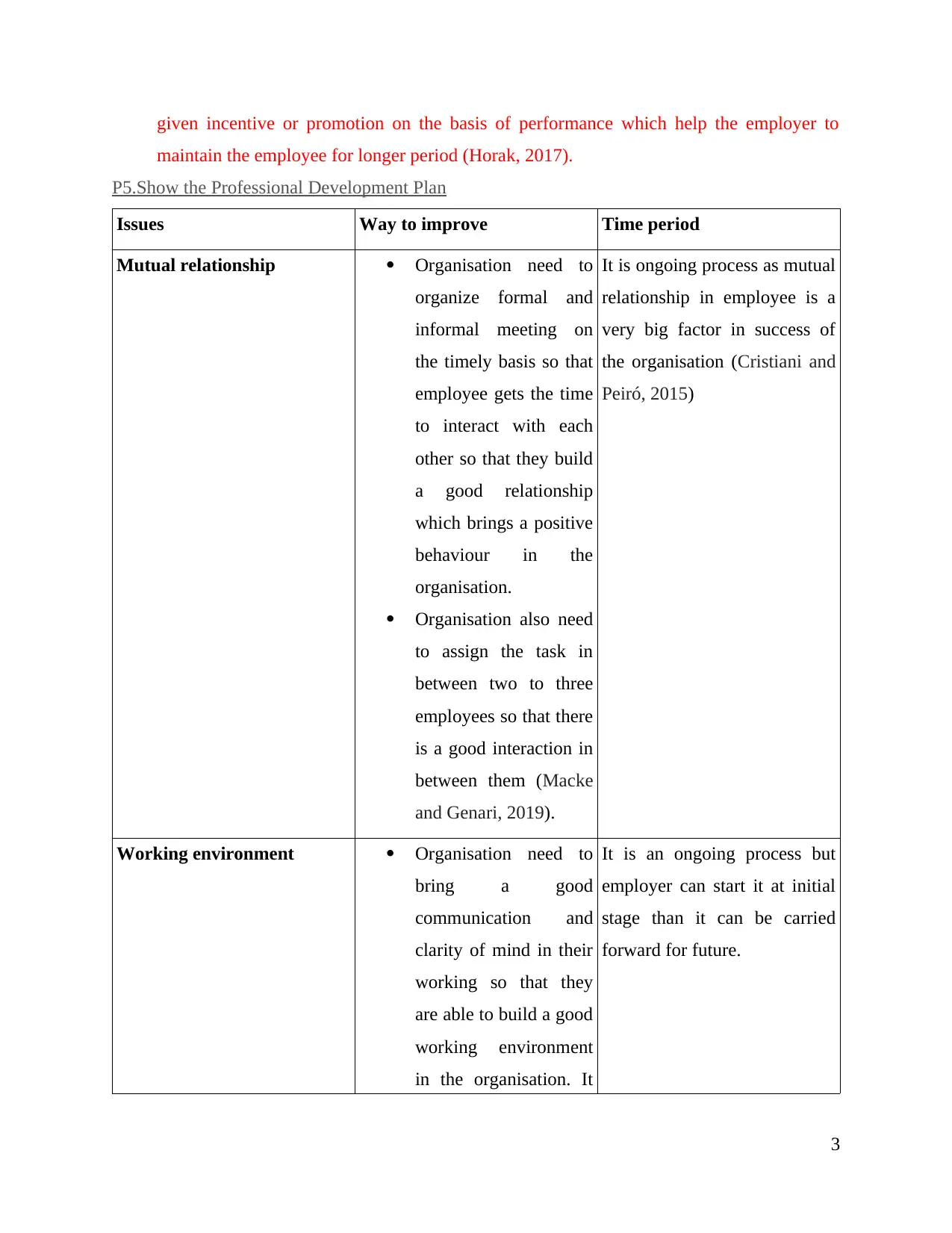
given incentive or promotion on the basis of performance which help the employer to
maintain the employee for longer period (Horak, 2017).
P5.Show the Professional Development Plan
Issues Way to improve Time period
Mutual relationship Organisation need to
organize formal and
informal meeting on
the timely basis so that
employee gets the time
to interact with each
other so that they build
a good relationship
which brings a positive
behaviour in the
organisation.
Organisation also need
to assign the task in
between two to three
employees so that there
is a good interaction in
between them (Macke
and Genari, 2019).
It is ongoing process as mutual
relationship in employee is a
very big factor in success of
the organisation (Cristiani and
Peiró, 2015)
Working environment Organisation need to
bring a good
communication and
clarity of mind in their
working so that they
are able to build a good
working environment
in the organisation. It
It is an ongoing process but
employer can start it at initial
stage than it can be carried
forward for future.
3
maintain the employee for longer period (Horak, 2017).
P5.Show the Professional Development Plan
Issues Way to improve Time period
Mutual relationship Organisation need to
organize formal and
informal meeting on
the timely basis so that
employee gets the time
to interact with each
other so that they build
a good relationship
which brings a positive
behaviour in the
organisation.
Organisation also need
to assign the task in
between two to three
employees so that there
is a good interaction in
between them (Macke
and Genari, 2019).
It is ongoing process as mutual
relationship in employee is a
very big factor in success of
the organisation (Cristiani and
Peiró, 2015)
Working environment Organisation need to
bring a good
communication and
clarity of mind in their
working so that they
are able to build a good
working environment
in the organisation. It
It is an ongoing process but
employer can start it at initial
stage than it can be carried
forward for future.
3
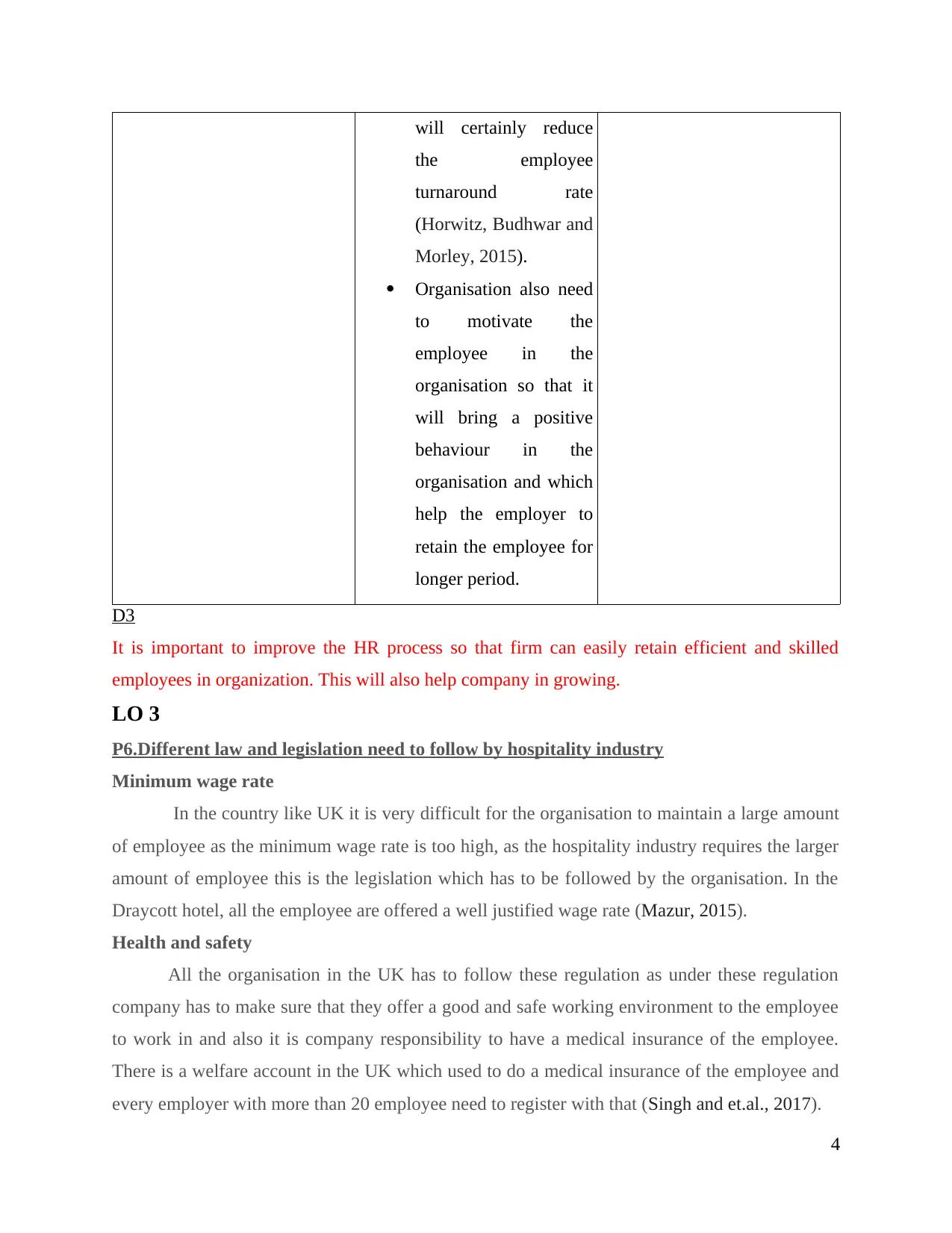
will certainly reduce
the employee
turnaround rate
(Horwitz, Budhwar and
Morley, 2015).
Organisation also need
to motivate the
employee in the
organisation so that it
will bring a positive
behaviour in the
organisation and which
help the employer to
retain the employee for
longer period.
D3
It is important to improve the HR process so that firm can easily retain efficient and skilled
employees in organization. This will also help company in growing.
LO 3
P6.Different law and legislation need to follow by hospitality industry
Minimum wage rate
In the country like UK it is very difficult for the organisation to maintain a large amount
of employee as the minimum wage rate is too high, as the hospitality industry requires the larger
amount of employee this is the legislation which has to be followed by the organisation. In the
Draycott hotel, all the employee are offered a well justified wage rate (Mazur, 2015).
Health and safety
All the organisation in the UK has to follow these regulation as under these regulation
company has to make sure that they offer a good and safe working environment to the employee
to work in and also it is company responsibility to have a medical insurance of the employee.
There is a welfare account in the UK which used to do a medical insurance of the employee and
every employer with more than 20 employee need to register with that (Singh and et.al., 2017).
4
the employee
turnaround rate
(Horwitz, Budhwar and
Morley, 2015).
Organisation also need
to motivate the
employee in the
organisation so that it
will bring a positive
behaviour in the
organisation and which
help the employer to
retain the employee for
longer period.
D3
It is important to improve the HR process so that firm can easily retain efficient and skilled
employees in organization. This will also help company in growing.
LO 3
P6.Different law and legislation need to follow by hospitality industry
Minimum wage rate
In the country like UK it is very difficult for the organisation to maintain a large amount
of employee as the minimum wage rate is too high, as the hospitality industry requires the larger
amount of employee this is the legislation which has to be followed by the organisation. In the
Draycott hotel, all the employee are offered a well justified wage rate (Mazur, 2015).
Health and safety
All the organisation in the UK has to follow these regulation as under these regulation
company has to make sure that they offer a good and safe working environment to the employee
to work in and also it is company responsibility to have a medical insurance of the employee.
There is a welfare account in the UK which used to do a medical insurance of the employee and
every employer with more than 20 employee need to register with that (Singh and et.al., 2017).
4
⊘ This is a preview!⊘
Do you want full access?
Subscribe today to unlock all pages.

Trusted by 1+ million students worldwide
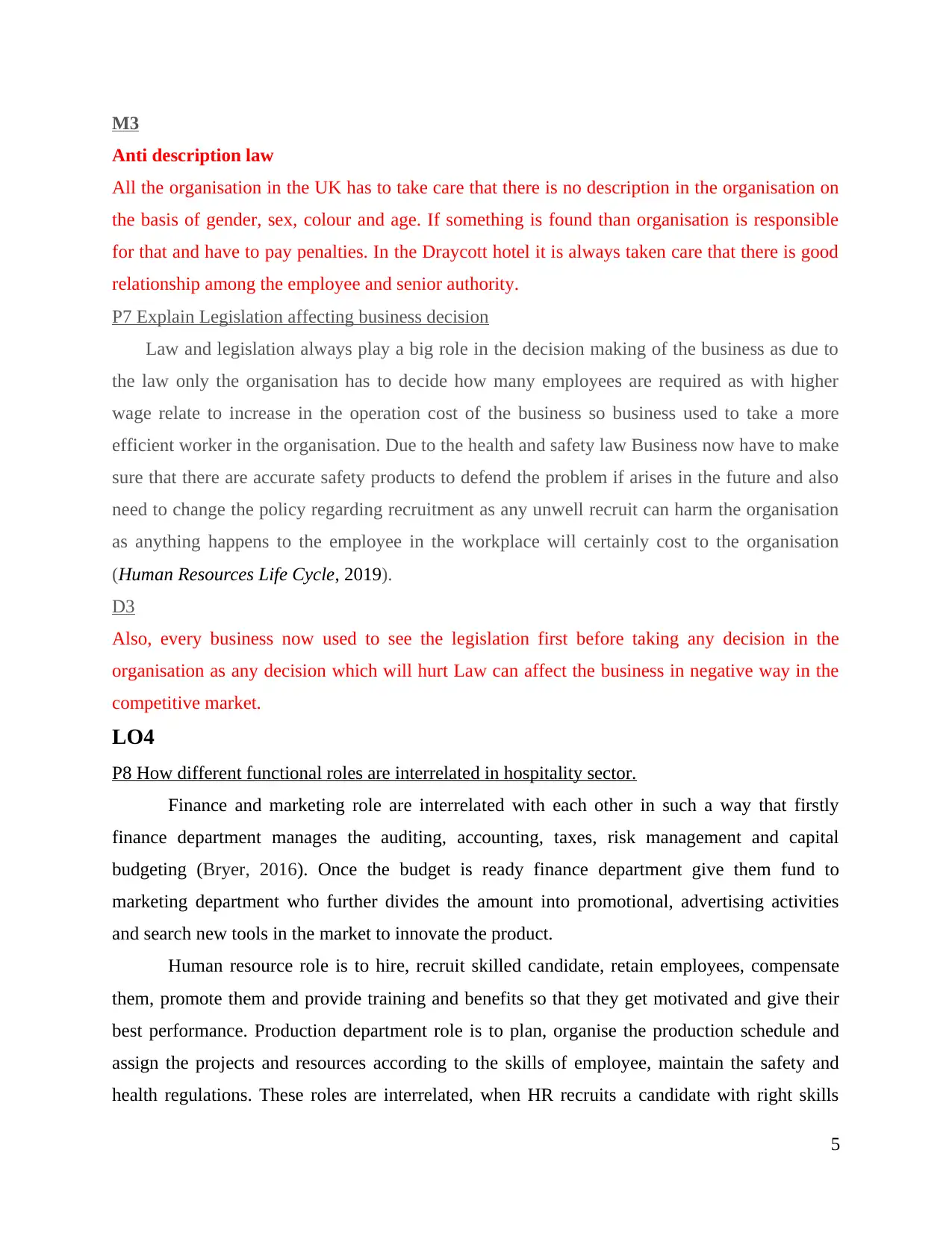
M3
Anti description law
All the organisation in the UK has to take care that there is no description in the organisation on
the basis of gender, sex, colour and age. If something is found than organisation is responsible
for that and have to pay penalties. In the Draycott hotel it is always taken care that there is good
relationship among the employee and senior authority.
P7 Explain Legislation affecting business decision
Law and legislation always play a big role in the decision making of the business as due to
the law only the organisation has to decide how many employees are required as with higher
wage relate to increase in the operation cost of the business so business used to take a more
efficient worker in the organisation. Due to the health and safety law Business now have to make
sure that there are accurate safety products to defend the problem if arises in the future and also
need to change the policy regarding recruitment as any unwell recruit can harm the organisation
as anything happens to the employee in the workplace will certainly cost to the organisation
(Human Resources Life Cycle, 2019).
D3
Also, every business now used to see the legislation first before taking any decision in the
organisation as any decision which will hurt Law can affect the business in negative way in the
competitive market.
LO4
P8 How different functional roles are interrelated in hospitality sector.
Finance and marketing role are interrelated with each other in such a way that firstly
finance department manages the auditing, accounting, taxes, risk management and capital
budgeting (Bryer, 2016). Once the budget is ready finance department give them fund to
marketing department who further divides the amount into promotional, advertising activities
and search new tools in the market to innovate the product.
Human resource role is to hire, recruit skilled candidate, retain employees, compensate
them, promote them and provide training and benefits so that they get motivated and give their
best performance. Production department role is to plan, organise the production schedule and
assign the projects and resources according to the skills of employee, maintain the safety and
health regulations. These roles are interrelated, when HR recruits a candidate with right skills
5
Anti description law
All the organisation in the UK has to take care that there is no description in the organisation on
the basis of gender, sex, colour and age. If something is found than organisation is responsible
for that and have to pay penalties. In the Draycott hotel it is always taken care that there is good
relationship among the employee and senior authority.
P7 Explain Legislation affecting business decision
Law and legislation always play a big role in the decision making of the business as due to
the law only the organisation has to decide how many employees are required as with higher
wage relate to increase in the operation cost of the business so business used to take a more
efficient worker in the organisation. Due to the health and safety law Business now have to make
sure that there are accurate safety products to defend the problem if arises in the future and also
need to change the policy regarding recruitment as any unwell recruit can harm the organisation
as anything happens to the employee in the workplace will certainly cost to the organisation
(Human Resources Life Cycle, 2019).
D3
Also, every business now used to see the legislation first before taking any decision in the
organisation as any decision which will hurt Law can affect the business in negative way in the
competitive market.
LO4
P8 How different functional roles are interrelated in hospitality sector.
Finance and marketing role are interrelated with each other in such a way that firstly
finance department manages the auditing, accounting, taxes, risk management and capital
budgeting (Bryer, 2016). Once the budget is ready finance department give them fund to
marketing department who further divides the amount into promotional, advertising activities
and search new tools in the market to innovate the product.
Human resource role is to hire, recruit skilled candidate, retain employees, compensate
them, promote them and provide training and benefits so that they get motivated and give their
best performance. Production department role is to plan, organise the production schedule and
assign the projects and resources according to the skills of employee, maintain the safety and
health regulations. These roles are interrelated, when HR recruits a candidate with right skills
5
Paraphrase This Document
Need a fresh take? Get an instant paraphrase of this document with our AI Paraphraser
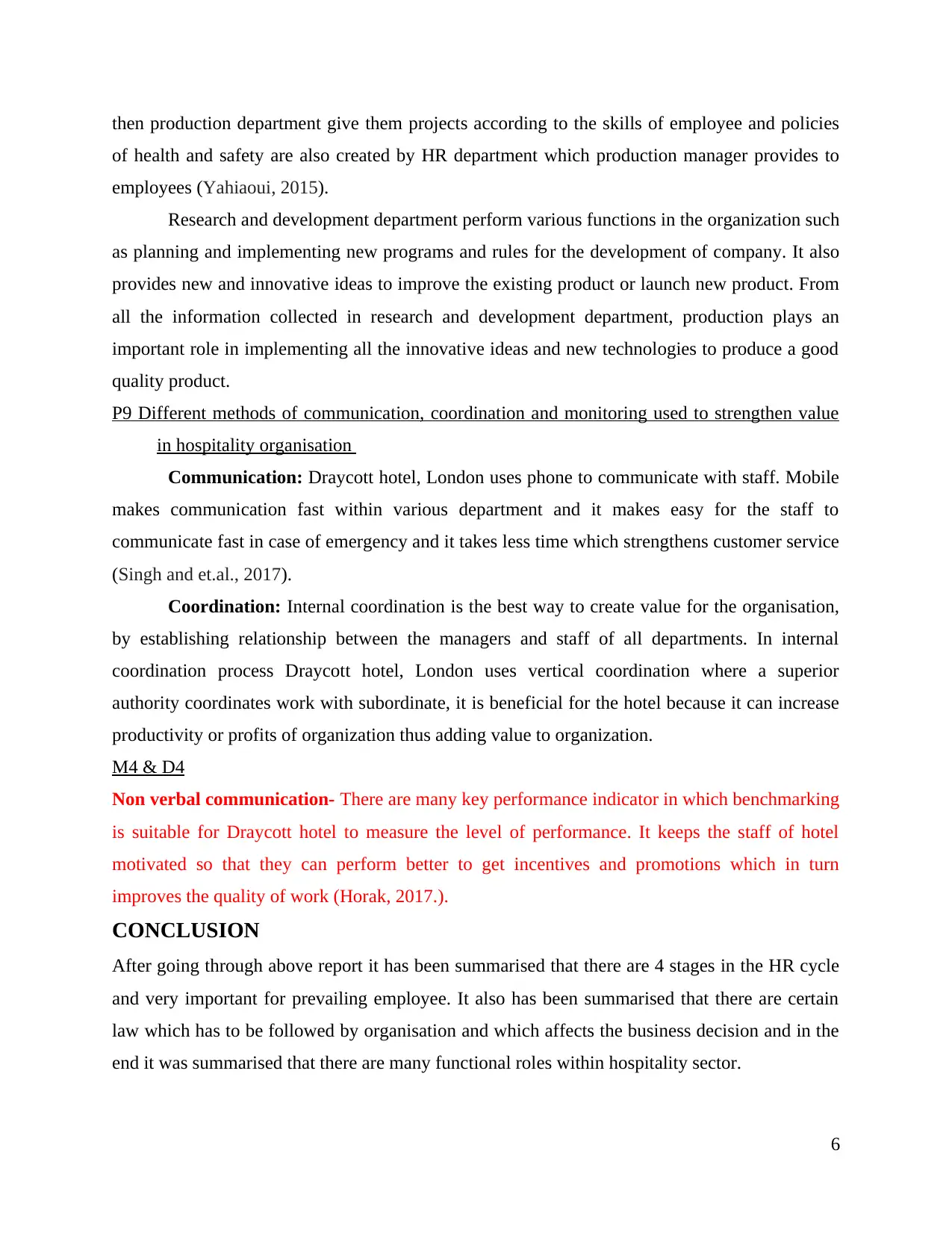
then production department give them projects according to the skills of employee and policies
of health and safety are also created by HR department which production manager provides to
employees (Yahiaoui, 2015).
Research and development department perform various functions in the organization such
as planning and implementing new programs and rules for the development of company. It also
provides new and innovative ideas to improve the existing product or launch new product. From
all the information collected in research and development department, production plays an
important role in implementing all the innovative ideas and new technologies to produce a good
quality product.
P9 Different methods of communication, coordination and monitoring used to strengthen value
in hospitality organisation
Communication: Draycott hotel, London uses phone to communicate with staff. Mobile
makes communication fast within various department and it makes easy for the staff to
communicate fast in case of emergency and it takes less time which strengthens customer service
(Singh and et.al., 2017).
Coordination: Internal coordination is the best way to create value for the organisation,
by establishing relationship between the managers and staff of all departments. In internal
coordination process Draycott hotel, London uses vertical coordination where a superior
authority coordinates work with subordinate, it is beneficial for the hotel because it can increase
productivity or profits of organization thus adding value to organization.
M4 & D4
Non verbal communication- There are many key performance indicator in which benchmarking
is suitable for Draycott hotel to measure the level of performance. It keeps the staff of hotel
motivated so that they can perform better to get incentives and promotions which in turn
improves the quality of work (Horak, 2017.).
CONCLUSION
After going through above report it has been summarised that there are 4 stages in the HR cycle
and very important for prevailing employee. It also has been summarised that there are certain
law which has to be followed by organisation and which affects the business decision and in the
end it was summarised that there are many functional roles within hospitality sector.
6
of health and safety are also created by HR department which production manager provides to
employees (Yahiaoui, 2015).
Research and development department perform various functions in the organization such
as planning and implementing new programs and rules for the development of company. It also
provides new and innovative ideas to improve the existing product or launch new product. From
all the information collected in research and development department, production plays an
important role in implementing all the innovative ideas and new technologies to produce a good
quality product.
P9 Different methods of communication, coordination and monitoring used to strengthen value
in hospitality organisation
Communication: Draycott hotel, London uses phone to communicate with staff. Mobile
makes communication fast within various department and it makes easy for the staff to
communicate fast in case of emergency and it takes less time which strengthens customer service
(Singh and et.al., 2017).
Coordination: Internal coordination is the best way to create value for the organisation,
by establishing relationship between the managers and staff of all departments. In internal
coordination process Draycott hotel, London uses vertical coordination where a superior
authority coordinates work with subordinate, it is beneficial for the hotel because it can increase
productivity or profits of organization thus adding value to organization.
M4 & D4
Non verbal communication- There are many key performance indicator in which benchmarking
is suitable for Draycott hotel to measure the level of performance. It keeps the staff of hotel
motivated so that they can perform better to get incentives and promotions which in turn
improves the quality of work (Horak, 2017.).
CONCLUSION
After going through above report it has been summarised that there are 4 stages in the HR cycle
and very important for prevailing employee. It also has been summarised that there are certain
law which has to be followed by organisation and which affects the business decision and in the
end it was summarised that there are many functional roles within hospitality sector.
6
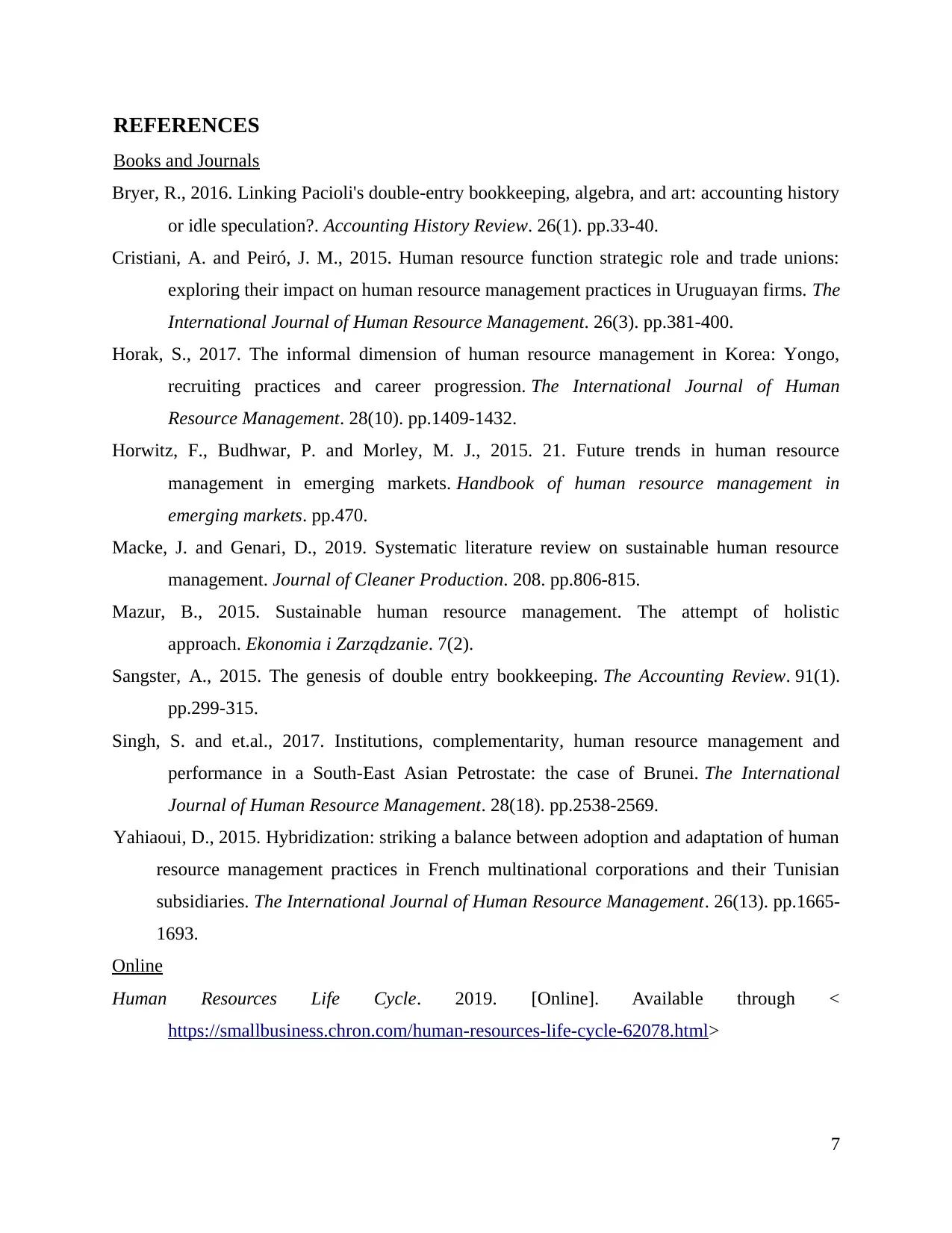
REFERENCES
Books and Journals
Bryer, R., 2016. Linking Pacioli's double-entry bookkeeping, algebra, and art: accounting history
or idle speculation?. Accounting History Review. 26(1). pp.33-40.
Cristiani, A. and Peiró, J. M., 2015. Human resource function strategic role and trade unions:
exploring their impact on human resource management practices in Uruguayan firms. The
International Journal of Human Resource Management. 26(3). pp.381-400.
Horak, S., 2017. The informal dimension of human resource management in Korea: Yongo,
recruiting practices and career progression. The International Journal of Human
Resource Management. 28(10). pp.1409-1432.
Horwitz, F., Budhwar, P. and Morley, M. J., 2015. 21. Future trends in human resource
management in emerging markets. Handbook of human resource management in
emerging markets. pp.470.
Macke, J. and Genari, D., 2019. Systematic literature review on sustainable human resource
management. Journal of Cleaner Production. 208. pp.806-815.
Mazur, B., 2015. Sustainable human resource management. The attempt of holistic
approach. Ekonomia i Zarządzanie. 7(2).
Sangster, A., 2015. The genesis of double entry bookkeeping. The Accounting Review. 91(1).
pp.299-315.
Singh, S. and et.al., 2017. Institutions, complementarity, human resource management and
performance in a South-East Asian Petrostate: the case of Brunei. The International
Journal of Human Resource Management. 28(18). pp.2538-2569.
Yahiaoui, D., 2015. Hybridization: striking a balance between adoption and adaptation of human
resource management practices in French multinational corporations and their Tunisian
subsidiaries. The International Journal of Human Resource Management. 26(13). pp.1665-
1693.
Online
Human Resources Life Cycle. 2019. [Online]. Available through <
https://smallbusiness.chron.com/human-resources-life-cycle-62078.html>
7
Books and Journals
Bryer, R., 2016. Linking Pacioli's double-entry bookkeeping, algebra, and art: accounting history
or idle speculation?. Accounting History Review. 26(1). pp.33-40.
Cristiani, A. and Peiró, J. M., 2015. Human resource function strategic role and trade unions:
exploring their impact on human resource management practices in Uruguayan firms. The
International Journal of Human Resource Management. 26(3). pp.381-400.
Horak, S., 2017. The informal dimension of human resource management in Korea: Yongo,
recruiting practices and career progression. The International Journal of Human
Resource Management. 28(10). pp.1409-1432.
Horwitz, F., Budhwar, P. and Morley, M. J., 2015. 21. Future trends in human resource
management in emerging markets. Handbook of human resource management in
emerging markets. pp.470.
Macke, J. and Genari, D., 2019. Systematic literature review on sustainable human resource
management. Journal of Cleaner Production. 208. pp.806-815.
Mazur, B., 2015. Sustainable human resource management. The attempt of holistic
approach. Ekonomia i Zarządzanie. 7(2).
Sangster, A., 2015. The genesis of double entry bookkeeping. The Accounting Review. 91(1).
pp.299-315.
Singh, S. and et.al., 2017. Institutions, complementarity, human resource management and
performance in a South-East Asian Petrostate: the case of Brunei. The International
Journal of Human Resource Management. 28(18). pp.2538-2569.
Yahiaoui, D., 2015. Hybridization: striking a balance between adoption and adaptation of human
resource management practices in French multinational corporations and their Tunisian
subsidiaries. The International Journal of Human Resource Management. 26(13). pp.1665-
1693.
Online
Human Resources Life Cycle. 2019. [Online]. Available through <
https://smallbusiness.chron.com/human-resources-life-cycle-62078.html>
7
⊘ This is a preview!⊘
Do you want full access?
Subscribe today to unlock all pages.

Trusted by 1+ million students worldwide
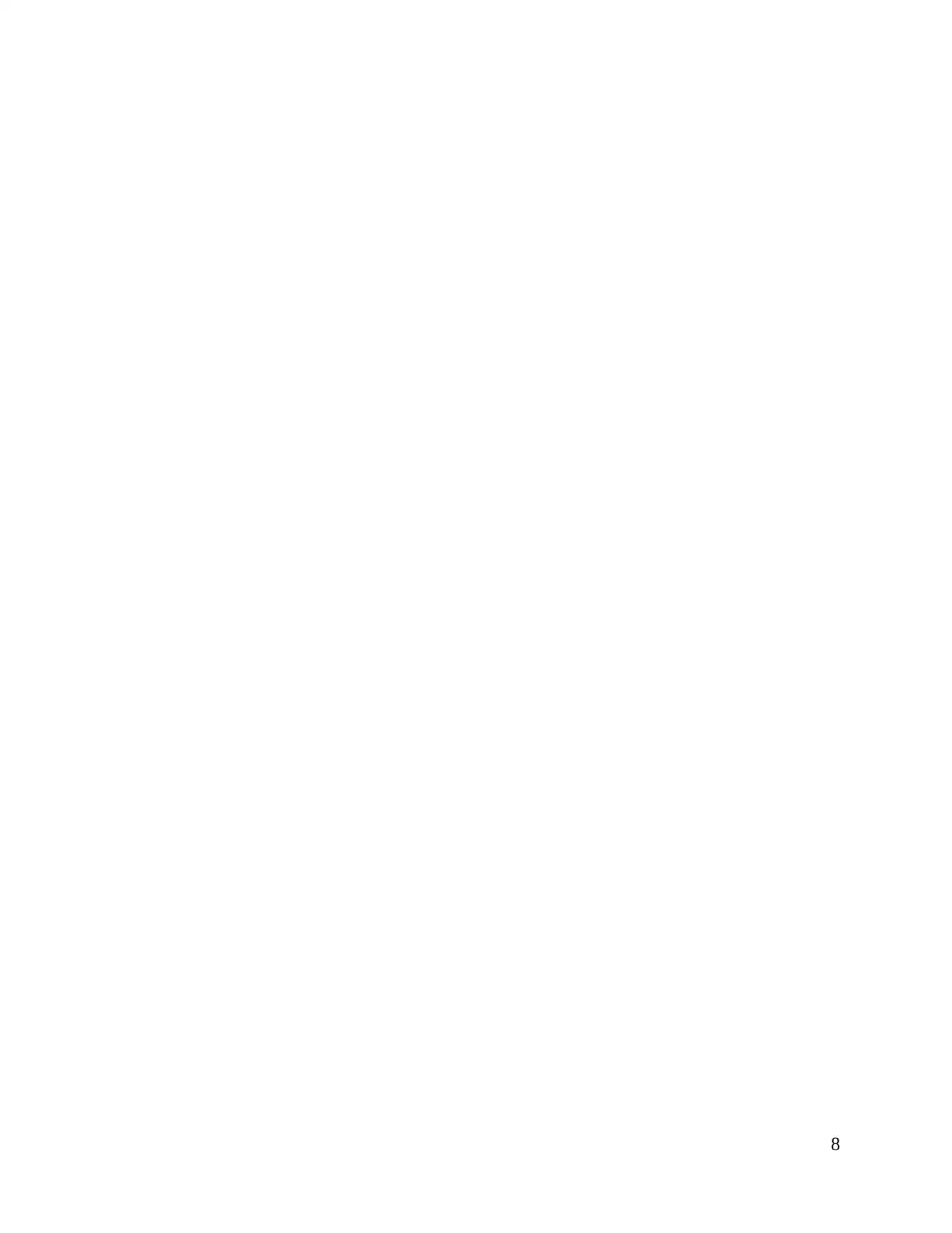
8
1 out of 10
Related Documents
Your All-in-One AI-Powered Toolkit for Academic Success.
+13062052269
info@desklib.com
Available 24*7 on WhatsApp / Email
![[object Object]](/_next/static/media/star-bottom.7253800d.svg)
Unlock your academic potential
Copyright © 2020–2025 A2Z Services. All Rights Reserved. Developed and managed by ZUCOL.





